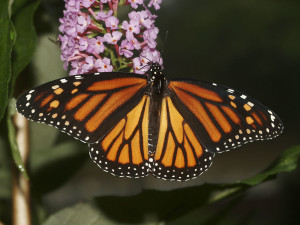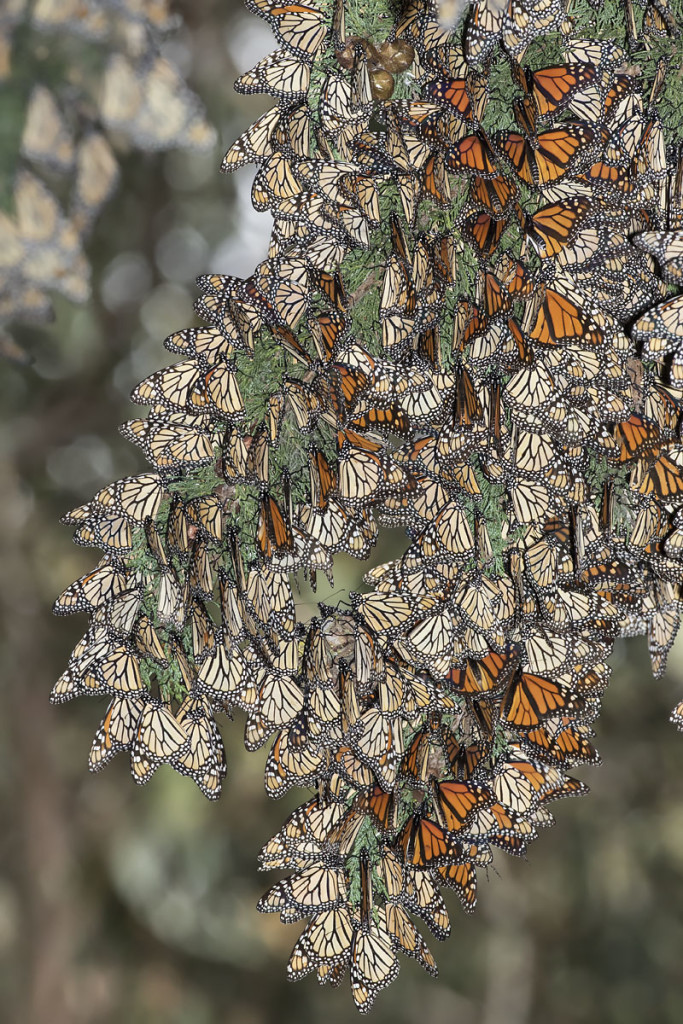Danaus plexippus plexippus
- Under Review – Endangered Species Act
- Sensitive – U.S. Forest Service

Photo by Bill Bouton.
The monarch butterfly is an important and iconic pollinator species known for its wintertime migration. In fact, it is the only butterfly that makes a two-way migration as birds do, using environmental cues to know when it’s time to travel south for the Winter. Then, as warm temperatures arrive in the Spring, they lay the eggs of the new generation, which then makes the return journey north. Some Monarchs fly as far as 3,000 miles to reach their winter home!
Several over-wintering sites are located in the Los Padres National Forest. Due to declines in monarch populations, the U.S. Forest Service recently placed the monarch on the formal list of “Sensitive Species.” In addition, several conservation organizations have requested that the monarch be placed on the federal endangered species list to provide additional protections.
Like all butterflies, monarchs begin their lives as caterpillars. After a two-week period, the caterpillars form a chrysalis and undergo complete metamorphism, and then after another two weeks, the butterfly emerges. Their entire life cycle thus spans only a few weeks.
This cycle repeats itself three to five times, with successive generations completing the migration to warmer climates to complete the overwintering process. Overwintering butterflies can live up to eight months as they undergo reproductive dormancy.
When the butterflies survive overwintering, and the temperatures warm they will migrate north and east once again, where they will breed and lay eggs on milkweed plants. The monarch is the only insect known to make a two-way migration; their migration distance is one of longest migrations known among insect species.
Habitat and Distribution
Two separate populations of monarchs inhabit North America — one to the east, and one to the west, of the Rocky Mountains. There are also small non-migrating populations, established in Florida, Mexico, Hawaii, Australia, Indonesia, and other islands in both the Pacific and Atlantic Oceans.

Monarch butterfly colony at Pismo Beach, CA. Photo by Bill Bouton.
For migrating populations, during the spring, summer, and early months of fall, the monarch is known to occupy warm areas where milkweed plants occur throughout the United States. The monarch butterfly travels thousands of miles to wait out the winter months. They travel far south into Mexico with many wintering sites located across the coast of California from Mendocino to San Diego County. The monarchs cluster in colonies, within eucalyptus, Monterey pines, and Monterey cypresses in California. The trees provide protection from wind and cold to ensure the monarch’s survival.
The overwintering stage, or the portion of the life cycle the Monarch spends in California and Mexico, is considered to be one of the most vulnerable time periods in the monarch’s life cycle.
Threats and Conservation
Monarch butterflies are vulnerable to activities that affect their habitat and their food sources. Milkweed habitat loss is a concern for butterflies. Primary causes of milkweed loss include industrialization, large-scale agriculture, and the prevalent use of herbicides. Milkweed decline in the western United States is also associated with the recent drought.
Overwintering habitat loss is also a major threat; the number of native trees and groves suitable for monarch overwintering was historically much greater than it is today. Since 1997, there has been about in 80% decline in monarch numbers at known overwintering sites along the California coast, and an overall 90% decline for both western and eastern populations.
Conservation of the monarch butterfly depends on the abundance and health of its overwintering habitat. Since a large portion of the butterflies cluster in only a few locations, they are especially vulnerable to activities that disrupt or destroy their wintering habitat. By identifying these areas we can better protect this important, iconic, and fascinating butterfly species.
In 2014, several conservation organizations submitted a petition requesting that the U.S. Fish and Wildlife Service list the monarch as a “threatened” species. This designation would protect the butterfly under the Endangered Species Act and provide additional protections to help the species recover. The agency determined that listing of the species may be warranted, and they requested more information about the monarch butterfly from the public.
Monarchs in the Los Padres National Forest
The Los Padres National Forest contains four known monarch groves where the monarchs overwinter, found primarily along the Big Sur coast. The U.S Forest Service listed the Monarch butterfly as a sensitive species in 2013. This means that the species receives increased attention whenever land use activities are proposed in or near its habitat. The listing ensures that forest officials will provide the monarch butterfly and its overwintering sites with adequate protection from harm. The Los Padres National Forest provides important overwintering habitat for the monarch, and continued protection of these sites is critical for the species’ survival.






